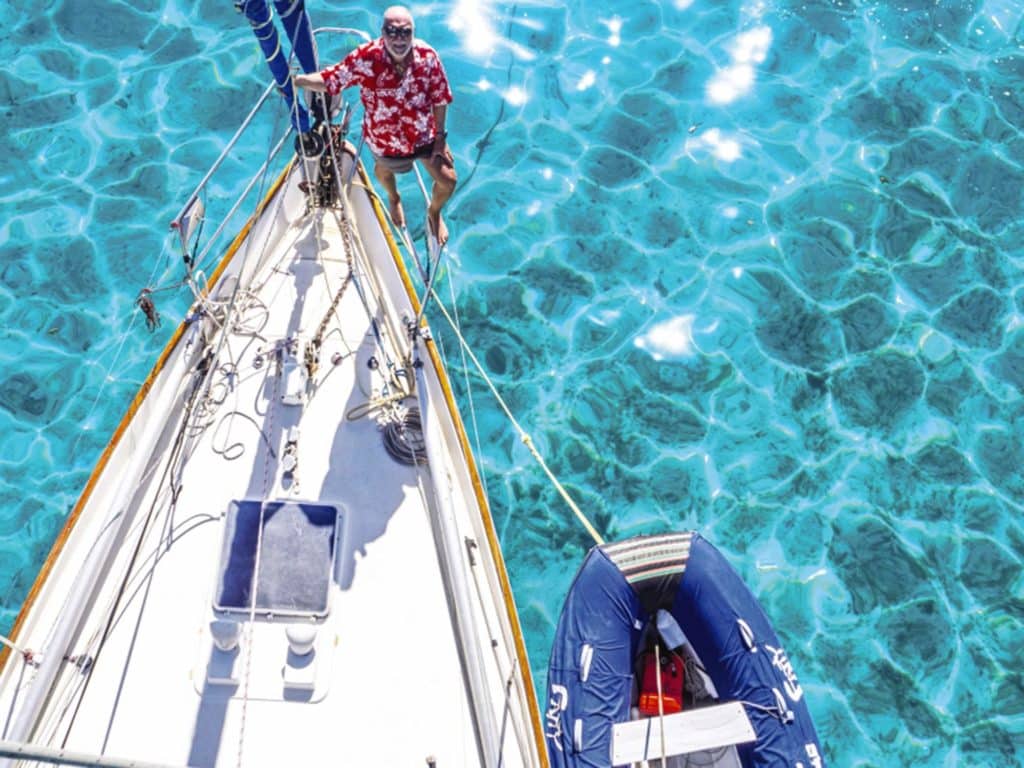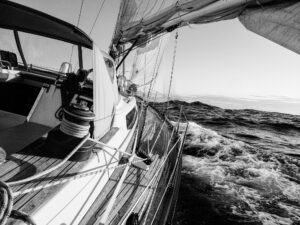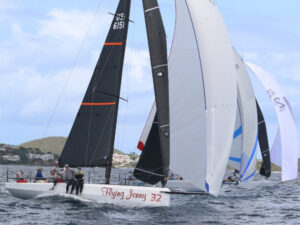
When it comes to things I wouldn’t cross an ocean without, my list starts first and foremost with a windvane. While I am loath to recommend expensive items, windvanes are far cheaper in the long run than electric autopilots. They are also more dependable and require no electricity. Best of all, they work better (by steering the boat farther and faster, with greater force) as the wind builds. I use a Monitor windvane and rebuild it, on average, every circumnavigation and a half—which translates to every 10 to 12 years.
I make a point of introducing myself to as many wannabe circumnavigators in the Panama Canal Zone as possible. Six months later, when I see them in New Zealand, I say, “I heard you had problems with your autopilot.” Rarely do they contradict me. Usually, they spew a sad-but-familiar tale of Tahitian repairs, defective parts in the Cook Islands, and lost air-freight shipments in Tonga.
Am I saying that there aren’t any dependable autopilots? Not all at. It’s just that they are often too heavy, too expensive and too energy-needy for most modest sailing yachts.
Let’s face it: If an electric-drive autopilot lasts through 350 or 500 hours of sailing off San Diego, that’s three or four years of dependable service, and that offers good value. But in my world, the damn thing usually packs up a mere one-third of the way to Tahiti. It’s a huge difference in perspective and value.
RELATED: How Not to Install a Self-Steering Windvane
We’ve even used our Monitor in heavy weather. It worked well (if the boat is correctly canvased and balanced) in winds up to 50 knots—especially off the wind and used in conjunction with slowing drogues if the breaking seas exceeded 18 feet or so.
Each boat is, of course, different, and your mileage may vary.
Certainly, modern autopilots are convenient and easy to use. I have seen several frugal sailors use small electric-tiller autopilots attached to their windvanes to steer while under power. We circumnavigated twice with this ($250) rig.
Why is having a device to steer the boat so important? Is it just laziness? No, it is not. Autopilots allow cruisers to rest, which allows them to be mentally engaged enough to practice proper seamanship. That’s what keeps you alive offshore: your sea sense.
And all the money in the world won’t help you offshore in mid-gale.
Reefing system
The next-most-important thing is your reefing system—note the word “system.” This needs to work flawlessly in the pitch-black while it’s blowing 50-plus knots with waves breaking aboard. No excuses. For us, that means slab reefing on our main and mizzen, and quality roller furlers on our jib and storm staysail. Plus, of course, we fly our dedicated storm trysail around such heavy air venues as the Cape of Storms (you might hear it called the Cape of Good Hope in South Africa) and across the southern Indian Ocean.
Here’s one of the most important truisms I know: An offshore sailor always has the proper amount of canvas showing. If you can’t reef your boat for the weather you might get, then you should not be out there, period. Hint: Most recreational craft have their aft reefing blocks too far forward. The sail should be able to be flattened in heavy air.
If we’re running before a gale in heavy airs, and Carolyn slides open the hatch, sticks her head out, smiles coquettishly, and says, “Why don’t we heave-to, skipper?” then I’m in her arms within five minutes. Yes, it takes a while to learn how to heave-to a specific vessel—but once the art of heaving-to is mastered, life offshore is bliss.
Anchoring system
Our anchoring (and slowing drogue) system is next in importance. Our primary anchor is a big Rocna with a generous amount of 10 mm chain. We have three different snubbers, a powerful Lofrans windlass, and a variety of snatch blocks. We use our anchor windlass to haul our anchor—and to haul our Para-Tech sea anchor, our Jordan Series Drogue, and various other slowing or balancing drogues. Oh, and to hoist stuff aboard as well. For instance, we swung aboard our new Perkins diesel using the windlass, via a halyard on our boom.
As far as anchoring goes, my goal is simple: I want to be able to safely anchor my boat in conditions of which most sailors would not dream. This requires a lot of gear—so much gear that we’ve removed a bunk and built a special “gear garage” in our walk-through between the main and aft cabins to accommodate our three spare anchors and the 1,200 feet of line we need to deploy them, as well as our storm gear.
Solar cells
The reason the first three boats I sailed extensively offshore had kerosene running lights was because kerosene was so much more dependable than electric running lights. I’m happy to report that we’ve made massive progress on this front. Now, solar cells and LEDs allow our boat to be continuously well-lit. Back in the days of my wild youth, only the crew could be described that way.
Best of all, solar cells let my bilge-pump system function dependably under battle conditions. I grew up on a 1924 carvel-planked schooner and moved from that to a 1932 Port Oxford cedar double-ender. I’ve swum around many a yacht interior as various vessels attempted to scuttle themselves. My bilge-pump system today includes a manually switched suction diaphragm pump (mounted high in my engine room) that can be run dry, and that pumps all but a few drops of water out of my bilge. I test this system every Sunday as part of my weekly “ship’s husband” chores.
Next, a faint buzzer in the cockpit sounds as my small, submersible bilge pump turns on. If, for some reason, that pump doesn’t pump, a very loud (like, wake-the-dead loud) bilge alarm rings. This can be heard by other vessels in the harbor—and my LED spreader lights blink to alert me if I’m ashore partying on the beach.
Next, my huge Big Daddy bilge pump kicks in. This throws a fair amount of water and, of course, draws a considerable amount of electricity.
If, despite all this, I’m offshore and my engine or batteries are about to go underwater, I have a hose-and-valve system that allows my Perkins diesel to pump out the bilge water. This is a last-ditch device because after a second or two without water, it will burn the impeller and my engine won’t work.
Finally, I have a large Edson manual pump that has proved itself to be handy in a pinch.
All this gear is independently wired and fused. Each pump has a massive bilge strainer.
Overkill? Perhaps. But in 62 years of living aboard and ocean sailing, I’ve never had a boat sink out from under me.
Sadly, it is difficult to circumnavigate these days without onboard email. We use a Pactor modem and Icom M710 SSB to do this; we know other sailors who rely on an Iridium satellite unit.
Noisemakers
I like buzzers and alarms—on my engine, on my knot meter, in my bilge, and in numerous other places. I have a 12-volt alarm called a Watch Commander that has a soft light, then a quiet buzzer and, finally, a brain-rattling sonic alarm. My wristwatch also has alarms, and can notify me with an audio or vibrating alarm (so that I don’t wake Carolyn).
AIS
The recent technological advance that I love the most is our Automatic Identification System. AIS, to me, is all plus and no minus—and it is cheap and requires almost no electrical power. I consider it the single-most-important anti-collision device developed in my lifetime.
Propane stove
The heart of a happy ship is its galley. We have a gimbaled, three-burner propane stove with an oven (and solenoid) that we love dearly. The moment our SSB radio tells us that a gale is coming, I go on deck to triple-lash our gear, and Carolyn fires up her stove. I’m soon back belowdecks and napping as Carolyn cooks. Thus, when the gale hits, I’m not only rested, but I’m also well-fed. Even better, we’ll continue to be well-nourished no matter how long the blow lasts because of the tasty, prepared meals awaiting us.
Auxiliary diesel
A dependable auxiliary diesel makes life easier. I cruised extensively for years without an engine on Corina and Wildcard, but those days are over. Ganesh weighs 35,000 pounds and takes an acre or two to turn around—plus, I’m beyond my 70th birthday. Thus, I have a muscular, low-revving Perkins. If I hit the switch, it fires up.
Dinghy
Our dinghy is our car. And our truck. And our zippy motorcycle for coastal exploration. We have a 10.5-foot Caribe with a 10 hp Tohatsu that planes with both of us on board, plus a bag of groceries and a six pack of cold beer (the universal yardstick of cruising dinghies).
We never allow it to sit in the water overnight; we always hoist it. While we use the davits in protected waters, it is always double-lashed upside down on deck offshore. That way, it can double as an instant, pre-inflated life raft.
Because we always have a sun cover on them, we get, on average, about 12 years of hard service out of our inflatable dinghies. They are a good value, even for miserly cheapskates like us.
All the rest
Here are some things we have but, perhaps, value a tad less than most cruisers: life raft, EPIRB, refrigeration and watermaker.
Here are some things we don’t have and don’t want: air conditioning, a shore-power cord, cockpit speakers, a television set, electric sheet winches, a cockpit chart plotter, a wind-angle instrument, underwater lights, electric hatches, electric-hoisting davits, a satphone, a water heater and a cabin heater.
I believe the reason that we’re both so healthy, happy and energetic is that we know the universal desire for ease is a fool’s quest.
If you have plenty of money, budgeting isn’t important. If you don’t, it is. We focus on strength and safety issues first, and then buy ice cream if there are any freedom chips left.
Some of my choices might strike you as stupid—that’s fine. Different folks, different strokes. My only defense is that for the past 62 years, I’ve happily lived in foreign ports with a pocketful of pennies, aboard shabby vessels on their own hooks that are able to go to sea almost immediately, and I continue to do so in company with the woman I love.
Editor’s note: Carolyn and Fatty Goodlander are still refusing to grow up in Southeast Asia—or anywhere, for that matter.








